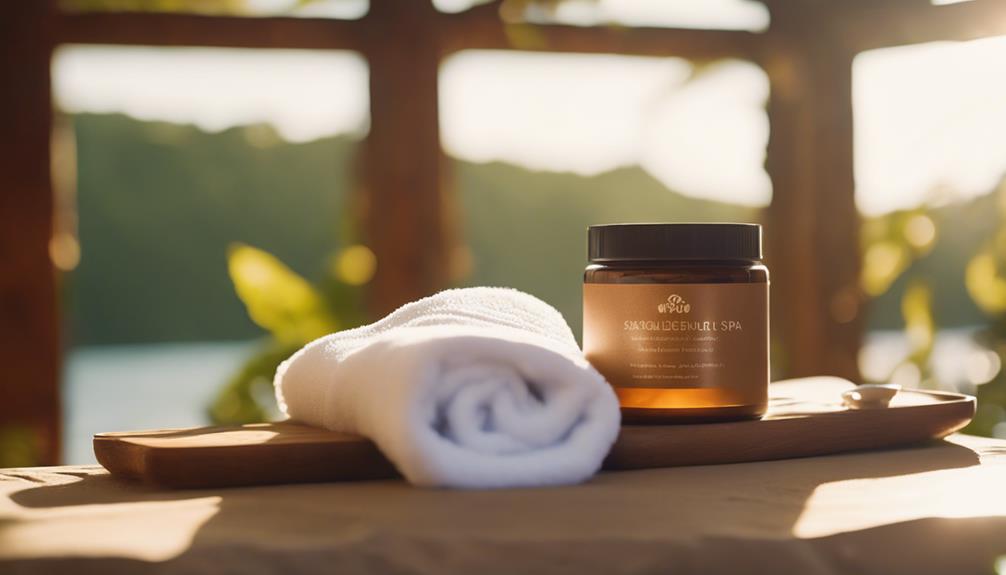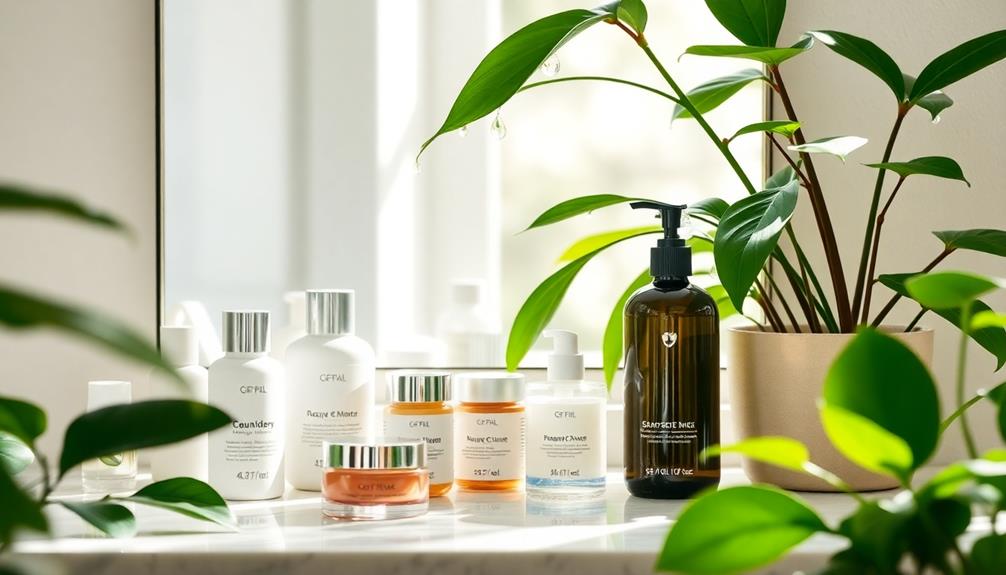Revealing your perfect tan is all about getting to know your skin type! Think of your skin as a unique sun sponge—it absorbs rays differently. If you've got lighter skin, you'll want to ease into sun exposure to avoid turning beet red. Meanwhile, darker skin can soak up more sun without burning. And remember, melanin is like your skin's built-in sunscreen! Use it to your advantage by choosing the right products, like bronzers with SPF for fair skin. So, whether you're a sun-lover or a shade seeker, there's more info out there to help you shine like a star!
Key Takeaways
- Identify your Fitzpatrick Skin Type to understand how your skin reacts to UV exposure and tailor your tanning strategy accordingly.
- Recognize your melanin levels; higher melanin means easier tanning and less burning risk, while lighter skin requires more gradual exposure.
- Prepare your skin by moisturizing and gradually increasing sun exposure to prevent burns and achieve an even tan.
- Choose the right tanning products based on your skin type; fair skin benefits from bronzers with SPF while dry skin needs rich moisturizers.
Understanding Skin Types
To effectively choose the right tan for your skin, it's crucial to understand your unique skin type and how it reacts to UV exposure.
Think of your skin like a chameleon; it adapts to its environment, but not all chameleons are the same!
You've got to know if you're a sun-loving type or someone who burns at the slightest hint of sunlight. The Fitzpatrick Skin Types scale can help, but remember, it's just a guideline. You might be a mix or something entirely different!
Try a sunlight reaction test to see how your skin behaves.
By knowing your skin's characteristics, you can craft a personalized tanning strategy that not only looks great but keeps your skin safe and happy.
Melanin and Tanning Potential

Melanin plays an essential role in determining your tanning potential and how your skin responds to UV exposure. Think of melanin as your skin's natural sunscreen; the more you have, the better your skin can handle the sun!
If you've got darker skin, you're likely to tan more easily and burn less often. That's because your higher melanin levels act like a protective shield.
On the flip side, if you have lighter skin, you might want to take it slow under the sun. Remember, everyone's unique!
UV Sensitivity and Tanning

Understanding your skin's UV sensitivity is essential for achieving a safe and effective tan without risking burns or damage.
Think of your skin as a unique canvas; some people can handle the sun like a pro, while others might need a bit more TLC. If you've got lighter skin, you might burn faster than a marshmallow over a campfire—so take it slow!
On the flip side, if your skin has more melanin, you're likely to tan beautifully with less fuss. Knowing your skin type helps you find that sweet spot for tanning.
Preparing for Safe Tanning

Before you head out for tanning, make sure you're properly prepared to protect your skin and achieve the best results.
Think of your skin like a delicious cake—you want it to be just right, not burnt! Start by checking your skin type; this helps you know how long you can bask in the sun without turning into a lobster.
Gradually increase your time in the sun; don't plunge in headfirst! And remember to hydrate your skin with a good moisturizer; dry skin can lead to uneven tans, like a patchy paint job.
Also, don't forget your sunglasses—protect those peepers! With a little prep, you'll be on your way to a fabulous tan that's safe and glowing!
Choosing the Right Products

Selecting the right tanning products is essential for achieving a safe and effective tan that complements your skin type. Think of your skin as a canvas—using the wrong paint could ruin the masterpiece!
If you've got fair skin, opt for bronzers with SPF to shield against burns, while self-tanners can give you that sun-kissed glow without stepping outside.
Oily skin? Go for oil-free, water-based cleansers.
Dry skin thrives on rich moisturizers, so slather it on!
For combination skin, target those oily and dry spots with the right products.
And don't forget to test bronzer shades on your jawline to find your perfect match.
With the right tools in hand, you're one step closer to your golden glow!
Customizing Your Tanning Schedule

Now that you've chosen the right products, it's time to customize your tanning schedule to maximize your results while keeping your skin safe.
Think of your tanning sessions like a dance—you want to move gracefully, not rush into it!
- Start Slow: Begin with 5-10 minutes, then increase gradually.
- Listen to Your Skin: Pay attention to how your skin reacts after each session.
- Consult the Pros: Talk to trained sunbed operators for personalized advice.
- Frequency Matters: Aim for 2-3 sessions a week, allowing your skin time to recover.
Embracing Your Natural Tone

Embracing your natural tone is essential for showcasing your unique beauty and feeling confident in your skin.
Think of your skin tone like a canvas; it's perfect just the way it is! Instead of chasing after someone else's tan, celebrate what you've got.
Not everyone can rock that sun-kissed glow, and that's totally okay! Whether you're porcelain, caramel, or deep chocolate, your skin tells a story.
Frequently Asked Questions
Can Diet Influence My Tanning Results?
Yes, your diet can influence tanning results. Consuming foods rich in carotenoids, like carrots and sweet potatoes, boosts your skin's natural glow. Hydration's essential too, helping maintain skin health and improving your tanning experience.
How Often Should I Exfoliate Before Tanning?
Imagine your skin as a canvas; exfoliating regularly, about two to three times a week, preps it for the masterpiece of a tan. It clears away dullness, ensuring your glow shines through beautifully.
Are There Age-Related Factors Affecting Tanning?
Yes, age-related factors can affect tanning. As you age, your skin loses elasticity and moisture, making it more prone to damage. It's essential to adapt your tanning approach and skin care routine accordingly for best results.
What Are the Risks of Indoor Tanning?
Indoor tanning increases your risk of skin cancer, premature aging, and burns. You should be cautious, limit exposure, and consider safer alternatives to achieve your desired tan without compromising your skin's health.
Can I Tan if I Have Skin Conditions?
Even a sunflower needs care to bloom. If you have skin conditions, consult a dermatologist before tanning; they'll guide you on safe practices. Tailoring your approach can help you enjoy the sun without unwanted flare-ups.
Conclusion
Now that you’ve got the scoop on your skin, you’re ready to release your perfect tan like a painter with a fresh canvas! To achieve the best results, make sure to exfoliate and moisturize your skin before tanning. This will help the tanning solution adhere more evenly and last longer. Also, remember to protect your skin from harmful UV rays during your best tanning sessions by using a good quality sunscreen. With the proper preparation and care, you’ll be able to show off your perfect tan all summer long. For flawlessly tan tips, consider using a tanning mitt to apply the tanning solution, which can help to prevent streaking and ensure an even application. Additionally, after tanning, be sure to wear loose-fitting clothing to avoid smudging the tan while it sets. Lastly, stay hydrated and moisturized to prolong the life of your tan and keep your skin looking radiant. With these additional steps, you can maintain that perfect tan and feel confident all season long.
Remember, it's all about knowing your unique skin type and how it reacts to the sun.
So, take your time, choose the right products, and enjoy the process.
With a little patience and care, you'll glow like a summer sunset.
Embrace your natural beauty, and let your tan shine bright!
Happy tanning!









